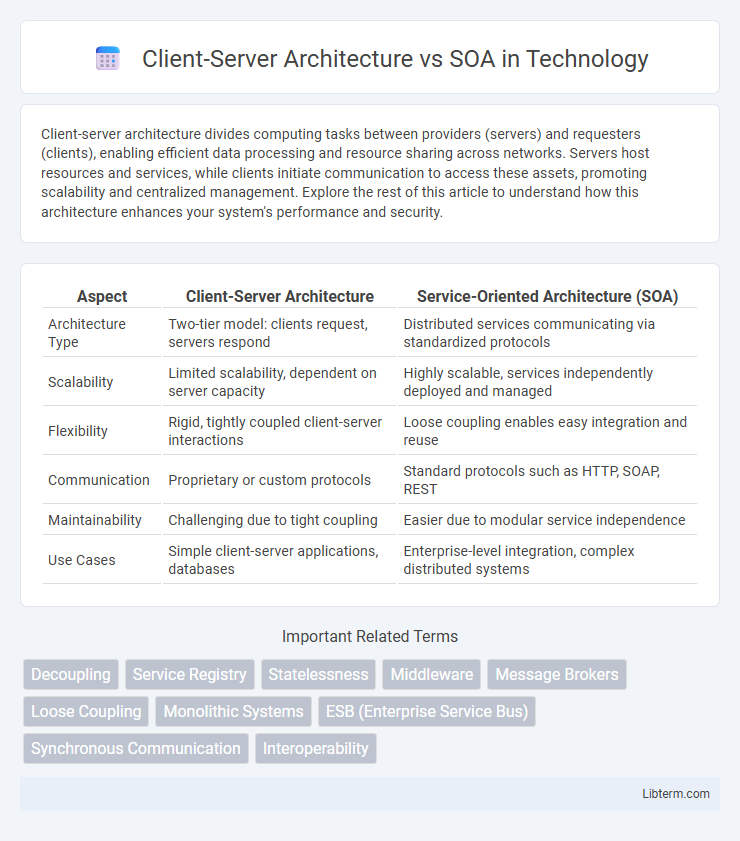Client-server architecture divides computing tasks between providers (servers) and requesters (clients), enabling efficient data processing and resource sharing across networks. Servers host resources and services, while clients initiate communication to access these assets, promoting scalability and centralized management. Explore the rest of this article to understand how this architecture enhances your system's performance and security.
Table of Comparison
| Aspect | Client-Server Architecture | Service-Oriented Architecture (SOA) |
|---|---|---|
| Architecture Type | Two-tier model: clients request, servers respond | Distributed services communicating via standardized protocols |
| Scalability | Limited scalability, dependent on server capacity | Highly scalable, services independently deployed and managed |
| Flexibility | Rigid, tightly coupled client-server interactions | Loose coupling enables easy integration and reuse |
| Communication | Proprietary or custom protocols | Standard protocols such as HTTP, SOAP, REST |
| Maintainability | Challenging due to tight coupling | Easier due to modular service independence |
| Use Cases | Simple client-server applications, databases | Enterprise-level integration, complex distributed systems |
Introduction to Client-Server Architecture and SOA
Client-server architecture is a distributed model where clients request services and servers provide responses, emphasizing direct communication between two parties. Service-Oriented Architecture (SOA) organizes software resources as reusable, loosely coupled services that enable interoperability across diverse platforms and applications. While client-server focuses on a fixed two-tier interaction, SOA promotes flexibility and scalability through service abstraction and standardized communication protocols.
Defining Client-Server Architecture
Client-Server Architecture is a network design model where multiple clients request and receive services from a centralized server, enabling efficient resource management and centralized control. This architecture typically involves distinct client and server roles, with the client responsible for the user interface and the server handling data processing, storage, and business logic. Emphasizing direct communication between clients and servers, it contrasts with SOA's loosely coupled, service-oriented framework designed for greater scalability and integration.
Understanding Service-Oriented Architecture (SOA)
Service-Oriented Architecture (SOA) is a design paradigm that structures software systems as a collection of loosely coupled services, promoting interoperability and reusability across heterogeneous platforms. Unlike Client-Server Architecture, which relies on a tightly integrated request-response model between client and server, SOA emphasizes standardized communication protocols, such as SOAP or REST, to enable flexible service composition and dynamic discovery. Enterprises leverage SOA to improve scalability, agility, and maintainability by decoupling service consumers from service providers, facilitating seamless integration across distributed environments.
Key Components of Client-Server Architecture
Client-Server Architecture consists primarily of two key components: the client, which initiates requests and interacts with the user, and the server, which processes those requests and provides resources or services. Clients rely on servers for data processing, while servers manage databases, application logic, and network resources to fulfill client demands. This architecture emphasizes a central server that handles requests from multiple clients, ensuring resource sharing, scalability, and efficient network communication.
Core Principles of SOA
Service-Oriented Architecture (SOA) is centered around modular, reusable services that communicate over a network to provide flexible integration, contrasting with the more rigid and monolithic Client-Server Architecture. SOA emphasizes loose coupling, interoperability, and discoverability of services, enabling systems to evolve independently while maintaining seamless interaction. Core principles include service abstraction, statelessness, and standardized service contracts, facilitating scalability, agility, and efficient resource utilization in complex enterprise environments.
Architectural Differences Between Client-Server and SOA
Client-server architecture relies on a direct communication model where clients request services from a centralized server, emphasizing tightly coupled and specific interactions. Service-Oriented Architecture (SOA) promotes loosely coupled services accessible through standardized interfaces, enabling interoperability and reusability across distributed systems. Unlike client-server, SOA uses a service bus or middleware to facilitate message exchanges and orchestrate complex business processes with greater scalability and flexibility.
Scalability and Flexibility Comparison
Client-Server Architecture scales primarily by adding more servers or enhancing server capabilities, which can lead to hardware bottlenecks and limited flexibility in integrating new services. Service-Oriented Architecture (SOA) supports scalability through loosely coupled, distributed services that can be independently deployed and scaled across heterogeneous environments. SOA's modular design enhances flexibility by enabling seamless service reuse, easier integration, and dynamic adaptation to changing business requirements.
Security Considerations in Both Architectures
Client-server architecture typically centralizes security controls at the server, requiring strong authentication, authorization, and encryption mechanisms to protect data in transit and at rest. In contrast, Service-Oriented Architecture (SOA) distributes security responsibilities across multiple loosely coupled services, necessitating advanced policies for secure message exchanges, token-based authentication, and continuous monitoring to defend against diverse threats. Both architectures must implement rigorous access control, data confidentiality, and integrity measures, but SOA's complexity demands more granular and dynamic security management to ensure comprehensive protection.
Real-World Use Cases: Client-Server vs SOA
Client-server architecture is commonly used in traditional web applications and online banking systems, where a centralized server processes requests from multiple client devices. Service-Oriented Architecture (SOA) is prevalent in large enterprises and cloud platforms, enabling integration of diverse services such as payment processing, inventory management, and customer relationship systems through loosely coupled, reusable components. Real-world use cases illustrate client-server's efficiency for simple, direct interactions, while SOA supports complex workflows and scalability across heterogeneous systems.
Choosing the Right Architecture for Your Business Needs
When choosing between Client-Server Architecture and Service-Oriented Architecture (SOA), businesses should evaluate scalability, flexibility, and integration needs. Client-Server Architecture offers straightforward implementation ideal for centralized control and less complex systems, while SOA provides modular services designed for interoperability across diverse platforms and asynchronous communication. Selecting the right architecture depends on long-term goals, with SOA better suited for enterprises requiring dynamic service reuse and cloud compatibility, whereas Client-Server fits smaller, tightly controlled environments.
Client-Server Architecture Infographic

 libterm.com
libterm.com